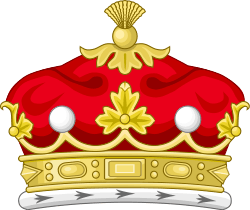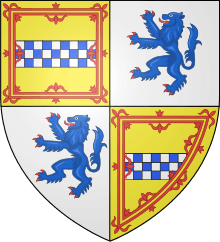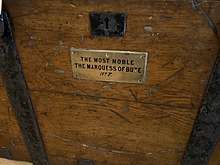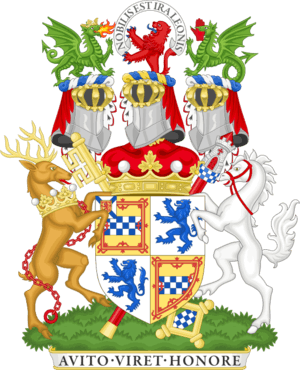Marquess of Bute
Marquess of the County of Bute, shortened in general usage to Marquess of Bute, is a title in the Peerage of Great Britain. It was created in 1796 for John Stuart, 4th Earl of Bute.
| Marquessate of the County of Bute | |
|---|---|
  | |
| Creation date | 2 February 1796 |
| Monarch | King George III |
| Peerage | Peerage of Great Britain |
| First holder | John Stuart |
| Present holder | John Crichton-Stuart, 7th Marquess of Bute |
| Heir apparent | John Crichton-Stuart, Earl of Dumfries |
| Remainder to | the 1st Marquess's heirs male of the body lawfully begotten |
| Subsidiary titles | Lord Mount Stuart; Baron Cardiff; Viscount of Kingarth; Viscount Mountjoy; Earl of Bute; Earl of Windsor |
| Status | Extant |
| Seat(s) | Mount Stuart House |
| Motto | Over the centre Crest: NOBILIS EST IRA LEONIS (The wrath of the lion is noble) Over the dexter Crest: GOD SEND GRACE Over the sinister Crest: Avito viret honore (To flourish in an honourable ancestry) |
| Currently the Earldom of Dumfries resides with the Marquesses of Bute. However, the Dumfries title can be inherited through the female line through an amendment to its original creation, and the title could be separated from the Marquesses of Bute should heirs presumptive to the titles of Bute and Dumfries, being male and female respectively, inherit. | |
Family history
John Stuart was the member of a family that descended from John Stewart (born 1360), Sheriff of Bute, a natural son of Robert II of Scotland and his mistress Moira Leitch, married to Janet Sympil and in 1407 to Elizabeth Graham. This John Stewart was granted the lands of Bute, Arran and Cumbrae by his father. He was known as the 'Black Stewart' because of his dark complexion; his brother John Stewart of Dundonald was known as the 'Red Stewart'. The grant of lands was confirmed in 1400 by a charter of Robert III.[2][3]
About 1385, John Stewart of Bute was granted the hereditary office of Sheriff of Bute by his father Robert II. He died in 1449, aged 89. At about the time of Mary, Queen of Scots, the family adopted the spelling of 'Stuart', which she had used while living in France.[2] James Stuart, seventh in descent from the Black Stewart, was created a Baronet, of Bute, in the Baronetage of Nova Scotia on 28 March 1627. His grandson, the third Baronet, represented Bute in the Parliament of Scotland and was one of the Commissioners that negotiated the Union between Scotland and England. On 14 April 1703, he was raised to the Peerage of Scotland as Lord Mount Stuart, Cumra and Inchmarnock, Viscount of Kingarth and Earl of Bute. He was succeeded by his son, the 2nd Earl of Bute and 2nd Lord Mountstuart, Cumra and Inchmarnock, and 4th Baronet. He sat in the House of Lords as a Scottish Representative Peer and served as Lord-Lieutenant of Buteshire. On his early death the titles passed to his son, the third Earl. He was a politician and favourite of George III, and served as Prime Minister of Great Britain from 1762 to 1763. Lord Bute married Mary, daughter of Edward Wortley Montagu and his wife, the writer Lady Mary Wortley Montagu. In 1761 Mary was raised to the Peerage of Great Britain in her own right as Baroness Mount Stuart, of Wortley in the County of York, with remainder to the heirs male of her body by her then husband Lord Bute.

They were both succeeded by their eldest son, the fourth Earl. In 1766, he married the Hon. Charlotte Jane, daughter and heiress of Herbert Windsor, 2nd Viscount Windsor, son of Thomas Windsor, 1st Viscount Windsor (see Viscount Windsor) and his wife Lady Charlotte, daughter of Philip Herbert, 7th Earl of Pembroke. Through this marriage vast estates in south Wales came into the Stuart family. In 1776, sixteen years before he succeeded his father in the earldom, he was raised to the Peerage of Great Britain in his own right as Baron Cardiff, of Cardiff Castle in the County of Glamorgan, in recognition of his substantial Welsh estates. In 1796, he was further honoured when he was created Earl of Windsor and Viscount Mountjoy, in the Isle of Wight, revivals of the titles held by his wife's family, and Marquess of the County of Bute. These titles are also in the Peerage of Great Britain. Lord Bute's eldest son and heir, John Stuart, Lord Mount Stuart (who predeceased his father), married Lady Elizabeth Penelope, daughter and heiress of Patrick McDouall, 6th Earl of Dumfries (see the Earl of Dumfries). Lord Mount Stuart's eldest son John succeeded his maternal grandfather as seventh Earl of Dumfries in 1803, and his paternal grandfather as second Marquess of Bute in 1814. In 1805, he assumed by Royal licence the additional surname of Crichton before Stuart. He was succeeded by his only child, the third Marquess. He was an antiquarian, scholar, philanthropist and architectural patron and also held the post of Lord-Lieutenant of Buteshire. It was the 3rd Marquess who first converted to Catholicism (in late 1868),[4] since which time the family have remained Catholic. His son, the fourth Marquess, was also Lord-Lieutenant of Buteshire. His grandson, John Crichton-Stuart, 6th Marquess of Bute (who succeeded his father), was Lord-Lieutenant of Buteshire from 1967 to 1975. As of 2013, the titles are held by the latter's eldest son, John Crichton-Stuart, 7th Marquess of Bute, who enjoyed a career as a racing driver during the 1980s.
Other offices and duties
The Marquess of Bute is the Hereditary Keeper of Rothesay Castle, a privilege granted to the ancestor of the Earls and Marquesses of Bute, John Stewart, by Robert II during the 14th century. In this capacity, the Crichton-Stuart family had been responsible for the upkeep and restoration of the castle up until the 1960s.[5][6]
This branch of the Stewart (also Stuart) family previously held the office of Hereditary High Steward of Scotland, an office now held by the Duke of Rothesay, in his capacity as a direct descendant of the House of Stuart.
Other family members
Numerous other members of the family have also gained distinction. Robert Stuart, younger son of the first Baronet, was created a Baronet in his own right in 1707. The Hon. James Stuart-Mackenzie, younger son of the second Earl, succeeded to the Mackenzie estates through his paternal grandmother and assumed by Royal licence the additional surname of Mackenzie. He was a member of parliament. The Hon. James Stuart-Wortley-Mackenzie, second son of the third Earl, was a politician and the father of James Stuart-Wortley, 1st Baron Wharncliffe (see the Earl of Wharncliffe for more information on this branch of the family). Lieutenant-General the Hon. Sir Charles Stuart, fourth son of the third Earl, was a distinguished soldier and the father of Charles Stuart, 1st Baron Stuart de Rothesay (see the Baron Stuart de Rothesay). The Most Reverend the Hon. William Stuart, fifth son of the third Earl, was Archbishop of Armagh. His son Sir William Stuart was a member of parliament. His eldest son William Stuart also sat as a member of parliament. Lady Louisa Stuart, daughter of the third Earl, was a writer. Lord Evelyn Stuart, second son of the first Marquess, was a soldier and politician. Lord Henry Crichton-Stuart, third son of the first Marquess, was the father of Henry Villiers-Stuart, 1st Baron Stuart de Decies (see the Baron Stuart de Decies for more information on this branch of the family).
Lord William Stuart, fourth son of the first Marquess, was a Captain in the Royal Navy and Member of Parliament. Lord George Stuart (1780–1841), fifth son of the first Marquess, was a Rear-Admiral in the Royal Navy. Lord Dudley Stuart, sixth son of the first Marquess (and eldest from his second marriage), was a member of parliament. Lord Patrick Crichton-Stuart, second son of Lord Mount Stuart, eldest son of the first Marquess, was Member of Parliament for Cardiff. His eldest son James Crichton-Stuart also represented this constituency in Parliament. Lord Ninian Crichton-Stuart, second son of the third Marquess, was also Member of Parliament for Cardiff before his early death in the First World War. Lord Colum Crichton-Stuart, third and youngest son of the third Marquess, sat as Member of Parliament for Northwich for many years. Lord Robert Crichton-Stuart, second son of the fourth Marquess, was Lord-Lieutenant of Buteshire.
The Earls and Marquesses of Bute originally used the courtesy title Lord Mount Stuart for the heir apparent. After the earldom of Dumfries was inherited by the second Marquess, the heir apparent has been styled Earl of Dumfries and his heir apparent is styled Lord Mount Stuart. The current heir John Bryson Crichton-Stuart was styled as Lord Mount Stuart for some years after his father inherited the marquessate in 1993. This was because his father was well known as, Johnny Dumfries, Earl of Dumfries. However, the current heir is now styled using the traditional title of the heir – Earl of Dumfries. He is known as Jack Dumfries for short, and his father is often known as John or Johnny Bute.
Heraldic achievement (coat of arms)
 |
Over the dexter Crest: GOD SEND GRACE, Over the sinister Crest: Avito viret honore (To flourish in an honourable ancestry)
|
Seats
The family seat is Mount Stuart near Rothesay on the Isle of Bute. Between 1994 and 2007, the current Marquess approached The National Trust for Scotland with offers to acquire Dumfries House, near Cumnock, East Ayrshire which had been the second seat of the Crichton-Stuarts since their union in 1792. In 2007 Dumfries House was acquired by a charitable trust, The Great Steward of Scotland's Dumfries House Trust, with financial support from The Prince Charles, Duke of Rothesay. Following refurbishment, it opened to the public on 6 June 2008.[8]
Stuart Baronets, of Bute (1627)
- Sir James Stuart, 1st Baronet (d. 1662)
- Sir Dugald Stuart, 2nd Baronet (d. 1670)
- Sir James Stuart, 3rd Baronet (d. 1710) (created Earl of Bute in 1703)
Earls of Bute (1703)
- James Stuart, 1st Earl of Bute (d. 1710)
- James Stuart, 2nd Earl of Bute (d. 1723)
- John Stuart, 3rd Earl of Bute (1713–1792)
- John Stuart, 4th Earl of Bute (1744–1814) (created Marquess of Bute in 1796)
Marquesses of Bute (1796)
- John Stuart, 1st Marquess of Bute (1744–1814)
- John Crichton-Stuart, 2nd Marquess of Bute (1793–1848) (had succeeded as Earl of Dumfries in 1803)
- John Patrick Crichton-Stuart, 3rd Marquess of Bute (1847–1900)
- John Crichton-Stuart, 4th Marquess of Bute (1881–1947)
- John Crichton-Stuart, 5th Marquess of Bute (1907–1956)
- John Crichton-Stuart, 6th Marquess of Bute (1933–1993)
- John Colum Crichton-Stuart, 7th Marquess of Bute (b. 1958)
The heir apparent is the present holder's son John Bryson Crichton-Stuart, Earl of Dumfries (b. 1989).
Barons Mount Stuart (1761)
- Mary Stuart, 1st Baroness Mount Stuart (1718–1794)
- John Crichton-Stuart, 4th Earl of Bute, 2nd Baron Mount Stuart (1744–1814) (created Marquess of Bute in 1796)
see above for further succession
Family Tree
| Sir James Stuart 1st Baronet (died 1662) | William Crichton 1st Earl of Dumfries (1578–1643) | ||||||||||||||||||||||||||||
| Sir Dugald Stuart 2nd Baronet (died 1670) | William Crichton 2nd Earl of Dumfries (1598–1691) | ||||||||||||||||||||||||||||
| James Stuart 1st Earl of Bute (died 1710) | John Dalrymple 1st Earl of Stair (1648-1706/7) | The Hon. Charles Chricton Lord Crichton | |||||||||||||||||||||||||||
| James Stuart 2nd Earl of Bute (died 1722/3) | Honourable William Dalrymple of Glenmure (died 1744) | Penelope Crichton suo jure 4th Countess of Dumfries (died 1741/2) | William Crichton 3rd Earl of Dumfries (died 1694) | ||||||||||||||||||||||||||
| John Stuart 3rd Earl of Bute (1713–1792) | Lady Elizabeth Daylrymple | William Dalrymple-Crichton 5th Earl of Dumfries 4th Earl of Stair (1699–1768) | |||||||||||||||||||||||||||
| John Stuart 1st Marquess of Bute (1744–1814) | Patrick McDouall-Crichton 6th Earl of Dumfries (1726–1803) | ||||||||||||||||||||||||||||
| Honourable John Stuart Viscount Mount Stuart (1767–1794) | Lady Elizabeth Penelope McDouall-Crichton (1772–1797) | ||||||||||||||||||||||||||||
| John Crichton-Stuart 2nd Marquess of Bute 7th Earl of Dumfries (1793–1848) | |||||||||||||||||||||||||||||
| John Patrick Crichton-Stuart 3rd Marquess of Bute 8th Earl of Dumfries (1847–1900) | |||||||||||||||||||||||||||||
| John Patrick Crichton-Stuart 4th Marquess of Bute 9th Earl of Dumfries (1881–1947) | |||||||||||||||||||||||||||||
| John Crichton-Stuart 5th Marquess of Bute 10th Earl of Dumfries (1907–1956) | |||||||||||||||||||||||||||||
| John Crichton-Stuart 6th Marquess of Bute 11th Earl of Dumfries (1933–1993) | |||||||||||||||||||||||||||||
| John Colum Crichton-Stuart 7th Marquess of Bute 12th Earl of Dumfries (born 1958) | |||||||||||||||||||||||||||||
| John Bryson Crichton-Stuart Lord Mount Stuart (born 1989) | |||||||||||||||||||||||||||||
See also
- Earl of Dumfries
- Viscount Windsor
- Earl of Wharncliffe
- Baron Stuart de Decies
- Baron Stuart of Wortley
- Stuart Baronets
- Clan Stuart of Bute
Notes
- Burke, John; Burke, Bernard (1851). Encyclopaedia of Heraldry: Or General Armory of England, Scotland, and Ireland, Comprising a Registry of All Armorial Bearings from the Earliest to the Present Time, Including the Late Grants by the College of Arms. H.G. Bohn. p. 989. Retrieved 13 October 2016.
- Stewart Clan Scots Connection (accessed 12 March 2008)
- Anderson, William, The Scottish Nation: or The Surnames, Families, Literature, Honours, and Biographical History of the People of Scotland (vol. I, ABE-CUR, Edinburgh, A. Fullarton & Co., 1862) pp 514–515, The Scottish nation Google Books, (accessed 12 March 2008)
- Bence-Jones, Mark, The Catholic Families (1992) London: Constable and Company Ltd., pp. 203–4
- "Rothesay Castle". Historic Scotland.
- A Guide to Rothesay Castle. Rothesay: Biggar & Co. 1870. p. 21.
- Burke, John; Burke, Bernard (1851). Encyclopaedia of Heraldry: Or General Armory of England, Scotland, and Ireland, Comprising a Registry of All Armorial Bearings from the Earliest to the Present Time, Including the Late Grants by the College of Arms. H.G. Bohn. p. 989. Retrieved 13 October 2016.
- Dumfries House accessed 11 June 2008. https://www.telegraph.co.uk/finance/property/8533968/Dumfries-House-a-Sleeping-Beauty-brought-back-to-life-by-the-Prince-of-Wales.html https://dumfries-house.org.uk/about/history
References
- Kidd, Charles, Williamson, David (editors). Debrett's Peerage and Baronetage (1990 edition) New York: St Martin's Press, 1990,